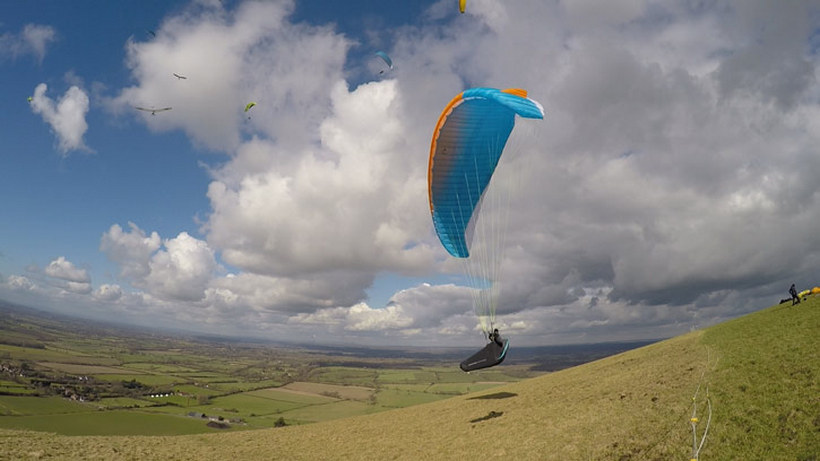
The Advance Alpha 5 was an outstanding first wing that took beginners well beyond the school environment. The updated design boasts less weight, fewer lines and double 3D shaping at the leading edge that is bound to give it more performance. The Alpha 6 also promises 'air scoop technology' that increases the stall resistance when flying slowly. With all these improvements, is it still suitable for training? Does it meet the needs of adventurous beginners and recreational pilots?
The Advance Alpha 6 comes with a good package: Advance's excellent Comfortpack 2 rucksack (available in 3 sizes, 100L, 115L and 130L); a high quality compression strap; Coverbag (a new style glider inner bag, made from lightweight, durable materials); a simple, lightweight riser bag made from Ripstop nylon; Advance Carbon Speed System (carbon speedbar with webbing loop, lines and Brummel hooks); a goodie bag made from Ripstop with repair kit (strips of coloured sticky-back Ripstop), stickers sheet and a cute Advance mini-windsock inside; a laminated business card-sized glider label with make, model, size, colours diagram and serial number printed on; and a useful, very nicely presented Getting Started mini-manual attached to the Coverbag. Everything oozes quality and attention to detail. For example, the Coverbag has small mesh parts near each of its two bottom corners, making it easier to squeeze the air out when you pack the wing in to it - a very nice little touch, to make the pilot's life easier.

Getting the wing out of the bag and unfolding it out on the slope, the usual top quality build and materials we've come to expect from Advance are immediately apparent. Everything is beautifully made, with nice attention to details: wing, lines, risers, and parts. Advance's new "Easy Connect System" (coloured marking system on the risers which, going forwards, will also match Advance harnesses) and their tried-and-tested big ear system with "Quick Snap" magnets also contribute to user-friendly setup and handling.
The new, improved brakes are very nice. Advance supply these in different sizes according to wing size as standard, which makes sense (the same with the risers). Personally, I prefer plastic coated magnets to metal poppers, but only if they are good quality and well designed - which the Advance ones are. I also like having swivels connections between the handles and the brake lines, to prevent brake line twisting, again only if they are good quality.
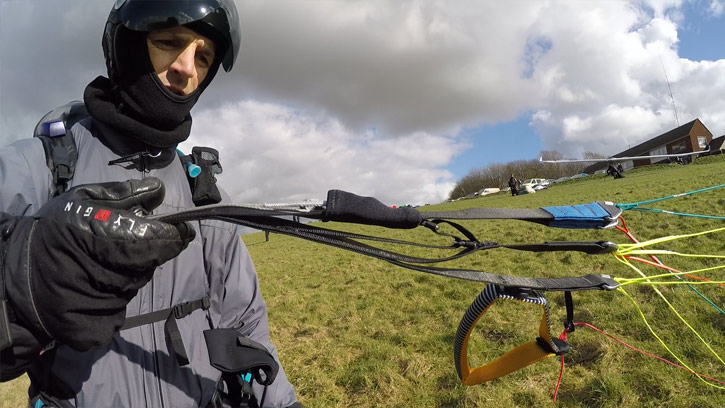
There's a moderate-to-strong breeze, mainly caused by the Venturi effect blowing over the hill, so I opt for a reverse launch, using the wind to open the wing out from a ball. The wing fills with air nicely, and the lines, which are relatively few and simply laid out, unfurl easily. The Alpha 6 has 20% less total line meters and 35 % fewer line items than its predecessor which, as well as being easier to manage on the ground and saving a bit of weight, suggests significantly better performance, due to substantially less parasitic drag, especially a higher speeds.
Often it's not so easy to hold EN A (and some low to mid EN B) rated wings down in stronger winds, since they tend to have bigger cell openings and be highly resistant to stalling, but I didn't find it too much trouble with the Alpha 6. It's still easier to hold the wing down in breezy conditions by using the rear risers in combination with the brake lines though, especially when a particularly strong wind comes through. I'm glad to see the rear risers don't have the stabilo lines attached to them, since if they were then when using the rear risers to hold the wing down in strong wind this would pull on the stabilos, causing the wing tips to come up, which makes this very useful technique less effective. Thankfully the stabilo lines are attached to the B risers, which is much better.
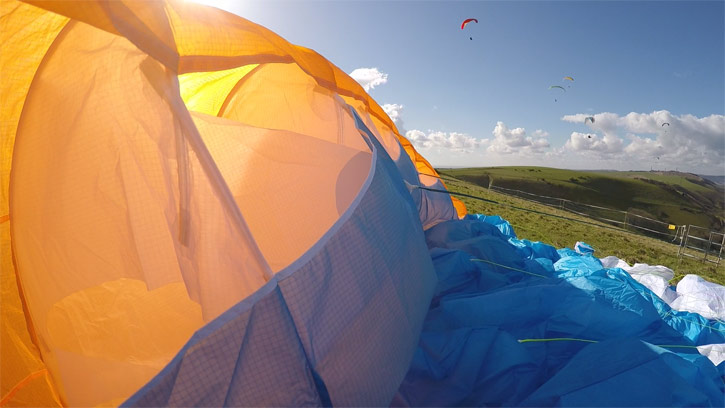
Pulling the wing up in to the air, it comes up very nicely, without any significant tendency to either hang back - i.e. no significant sticking point - on the way up or dive forwards on reaching the zenith of the arc. Pulling the wing up and down repeatedly, trying being gentle or heavy handed, symmetric and asymmetric, the Alpha 6 feels like it has a nice, balanced behaviour - not to slow or too fast - for the target pilot group i.e. new and occasional pilots looking for a wing with predictable, forgiving launch characteristics in all (sensible) wind conditions and take-off situations.
Holding the control (brake) handles at the bottom ("tourist position" as Advance chief test pilot Kari Eisenhut jokingly calls it) I found it quite hard to stall the wing down on the ground in a strong breeze (the Alpha 6 has 15% more brake travel than the Alpha 5); a quick full wrap of the brake lines and then I had no problem. The rear risers also work well to get the wing down in stronger conditions, and it's then easier to the hold it down with them too.
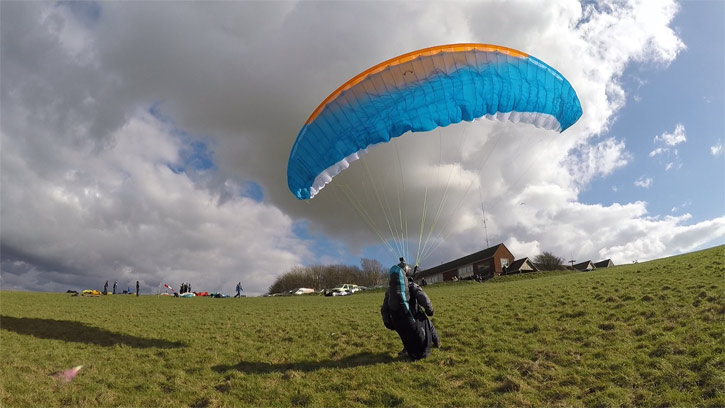
In the air, the Alpha 6 is surprisingly agile and nice to fly for such a safe and solid feeling wing, whilst being reassuringly dampened and forgiving of incorrect or imprecise inputs. The first part of the brake travel, where most of a pilot's turning will be done most of the time, is relatively light however as you pull the brakes down through their travel they firm up quickly, making it very hard to mistakenly over-input for all but the most heavy handed, long-armed ape-man. ;)
I was flying the Alpha on a windy, gusty early spring day with numerous biggish Cumulus congestus clouds lurking around the sky, some of them precipitating due to the cold. Despite being keen to fly, some pilots, probably still rusty from the winter lay off, chose to stay on the ground for most of the day; no doubt this was a wise choice for them, and good to see. I heard some who'd flown commenting that the conditions were rather bumpy and a bit too exciting for them at times; for some this might be because they fly wings which are too demanding for them, so they feel uncomfortable when the air gets more active. I'd recently returned from two weeks of XC flying in Colombia, where it was very turbulent at times (there were a few moments where I wish I'd being flying a wing as easy and forgiving as the Alpha 6!) so was feeling fairly current and extremely comfortable in the conditions - which were well within my personal margins. Hopefully this gives some idea of the kind of conditions I was testing the Alpha 6 in, for reference.
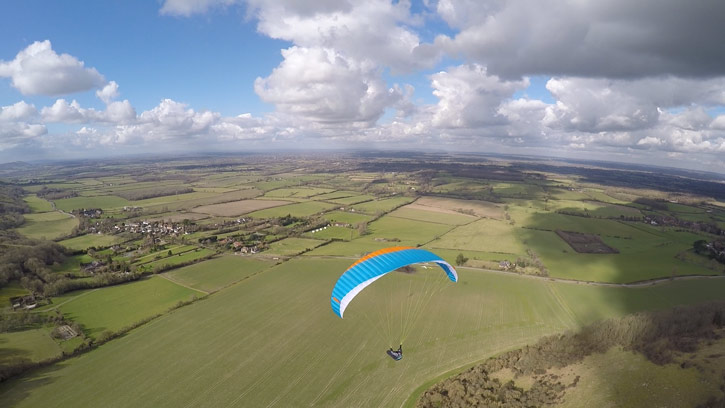
The Alpha 6 is very pitch dampened, smoothing out bumps and always wanting to stabilise and return to the overhead position quickly. In smooth air, I induced as big pitch oscillations as I could muster (without being too silly about it) and could not make it dive far enough forwards to collapse. I also tried some full stalls, to some's amusement and others' confusement, and let the wing dive out from overhead and still it didn't pitch far forward enough to collapse, quickly self-stabilising. I suspect this is also due to the wing being highly collapse resistant, from what I could tell during my testing by flying hands off through turbulence and seeing how the wing behaved; I didn't suffer any non-induced collapses whatsoever, where some others around me did.
Soaring up and down the ridge between thermal cycles, the Alpha 6 seemed to be staying up well relative to others. Its trim speed and sink rate might be slightly less than some higher performance wings, but at least as good as comparable wings. It's always hard to tell anything meaningful in active air. Sometimes I was out-gliding a pilot flying a current top performing EN D wing as I flew through more buoyant air than he, other times strong headwind and heavy sink came through and felt like I was gliding like brick, and yet other times everyone seemed to gliding about the same. Performance comparisons in active air are mostly pointless!
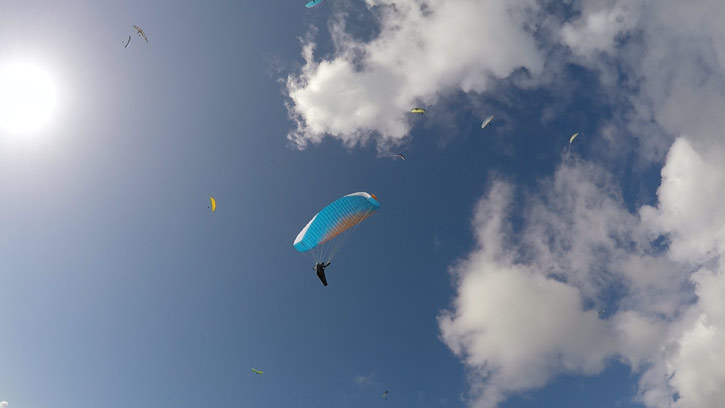
In thermals the Alpha 6 seemed to climb very well. In small, punchy cores forgiving, low aspect ratio wings like the Alpha 6 are great; you can really bury the brake to crank and bank the wing up, turning in a smaller radius far more easily than on higher aspect ratio wings, which tend to take up more space and stall/spin much more readily. The Alpha 6 tends to turn more flatly, which is more efficient but requires a bit more weight shift and brake to keep it in the turn - especially when in one of those small, punchy climbs which try to spit you out. I found that if I tried turning the wing with minimal weight shift i.e. using mostly the brakes then the brake pressure felt quite high when maintaining a tight turn in a small core. When I led in to the turn with plenty of weight shift, rolling and banking the wing, and continued using a good amount of weight shift during the turn, then less brake - and therefore less pressure - was required to keep it tight and core the best lift.
It being windy at times, and thermic/sucky enough to gain some good height, I had ample opportunity to try out the Alpha 6's speed system. I found the force required to apply it to be moderate to firm; neither light nor heavy. I was very impressed by how solid the wing continues to feel all the way through the travel, even on full bar, making the full speed range very usable. Up to two-thirds bar the sink rate doesn't increase too much and the glide remains impressively good for a wing of this class and high stability. In the last third of the speed system travel I found the sink rate increased noticeably more, as to be expected, but still relatively excellent. It seems to me that the Advance R&D team have sensibly given the Alpha 6 an effective speed system travel whilst keeping it safe and usable for the kinds of pilot they've designed it for i.e. recreational pilots, not head-banging racers!
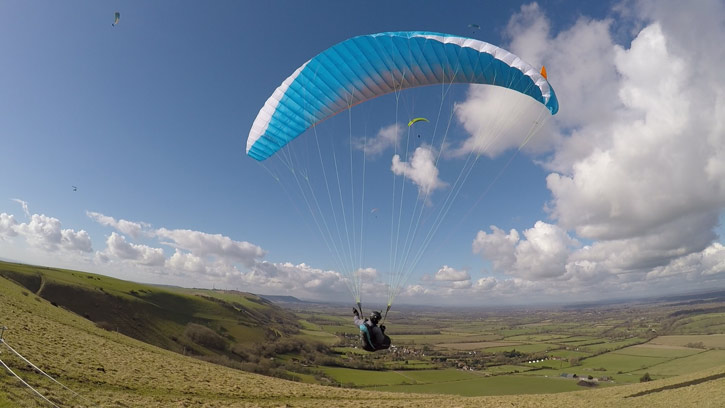
Regarding descent techniques, I found the Alpha 6 very straightforward. Big ears induced using only the spilt As grabbed at the maillons are quite small; too small to be very effective in a sucky situation. For more effective big ears you need to either grab higher up the lines (careful not to pull to much brake when you pull down, if you keep hold of the brakes) or use two A lines per side. Tip: It's generally wise to apply a bit of speed system when applying big ears to reduce the chance of deep stalling on any paraglider (the Alpha 6 didn't show any tendency to deep stall). I only tried one moderate spiral dive and found this to be easily controllable, with moderate Gs. Higher rated wings, which tend to have longer lines and a higher speed, seem to pull significantly more G to me; another safety advantage of lower aspect ratio wings i.e. it's easier to get down if you want to. I didn't try a B line stall; although 'B-lines' can still be useful in certain situations, most (if not all) manufacturers seem to recommend against these nowadays, explaining that it's not good for the wing (specifically, I think they mean the internal construction, which nowadays is usually highly optimised to save weight).
Testing the stall/spin point of the Alpha 6, I found that when using 'tourist position' with the controls, the wing teetered along on the point of stall for a long time before eventually stalling, and was then on the cusp of flying again. Taking a wrap it was of course much easier stalling the wing, and it stayed in the stall more cleanly. I found it easily controllable to ease the brakes up to rebuild the wing and, once I'd let the wing come back above my head after initially entering the stall, the moment at which I released to be non-critical. A big difference to some higher rated wings - even some EN B rated ones! Holding dynamic spin in for 180 degrees and releasing whilst the wing was behind (not the best thing to do) revealed similarly forgiving behaviour. You won't catch me doing that so easily with an EN D or C rated wing - or even some EN B rated wings!
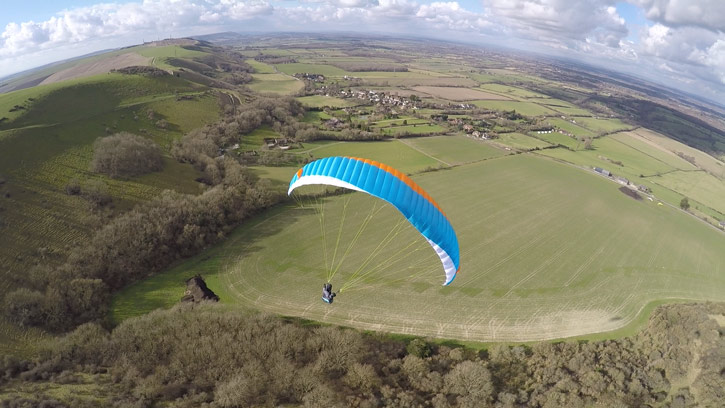
Inducing several symmetric and asymmetric collapses on the Alpha 6 was... well, laughable. I managed to induce some good sized collapses by yanking down hard on the risers but each time the wing just popped back out, hardly pitching or turning. It just shrugged it off nonchalantly. Excellent collapse recovery behaviour!
Side note: Perhaps all this stalling, spinning and collapsing of my wing for review purposes explains why some pilots were staying on the ground, watching me repeatedly falling out of the sky, not realising I was doing it on purpose? ;)
To finish off, I tried some moderate wing overs, which worked very nicely but don't build up as much energy or Gs as higher rated wings, and played around ground swooping when I knew I wouldn’t get in anyone's way. You can certainly have plenty of fun on the Alpha 6, once you've learnt how to control your wing properly. In fact I was probably having more fun, since I was so relaxed!
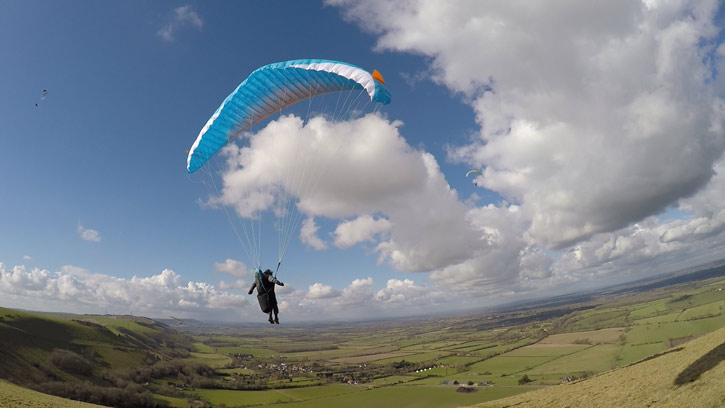
Coming in to top land, the Alpha 6's forgiving handling and natural pitch dampening make it easier to deal with the gusty, choppy air you tend to get near the ground i.e. you don't tend to balloon up and down as much as higher performance wings do when a gust comes through, making the approach more predictable. On the other hand, since the Alpha 6 is highly resistant to stalling it's harder getting it down in a stronger wind (than a higher rated wing) so you need to ensure you either flare firmly (best taking a wrap) or use the rear risers, whilst running towards the wing, to get it down nice and quickly. With correct technique, and not flying in silly winds, it isn't a problem. Compared to other EN A rated wings, I found the Alpha 6 relatively easy to manage in stronger winds.
In summary, I think the Alpha 6 is a fantastic option for a wide variety of more discerning pilots who appreciate Advance quality, from those starting out and getting in to flying all the way up to experienced weekend and holiday pilots looking for high safety, nice handling and excellent performance. For safety conscious XC enthusiasts the Alpha 6 has all the performance you need - and more - to get up high and fly far! Some schools with small training sites may even find the Alpha 6 has too much performance. The only time a pilot might find its performance lacking is when competitively comparing themselves to others on hotter wings. Great news is that the Alpha 6 comes in 5 sizes, meaning more choice for pilots, extending the minimum all-up weight down to 50 kg and having more overlap between the weight ranges of the different sizes. The +15kg extended weight ranges, also EN A certified, increase the weight range overlap even more, and are also a very attractive feature for acro newbies and paramotorists*.
*DGAC Paramotor Approval is currently under consideration for all ALPHA 6 sizes, except size 22.
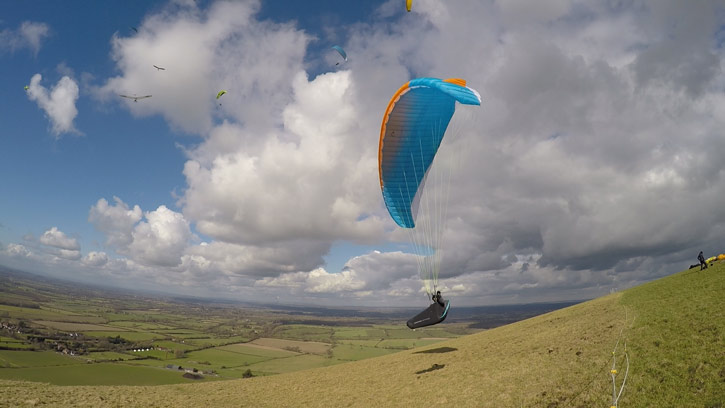
Technical info
ALPHA 6 26, flown at 89 kg. Recommended: 70-95 kg. Increased: 95-110 kg. Best: depends on pilot/conditions!
HARNESS USED: Advance Lightness 2.
TEST CONDITIONS: 2 hours in punchy thermic conditions, basewind 25km/h, 10deg C, 2m/s up to 2500ft.
TEST PILOT: paragliding professional, flying and instructing since 1992, over 5000 hours airtime, 100's of wings flown/reviewed. Currently flying: XC, Niviuk Artik 4​​; hike & fly, Niviuk Skin; mini wing, Skywalk TONIC; tandem, Advance BiBeta 5; PPG, Niviuk Kougar 2.
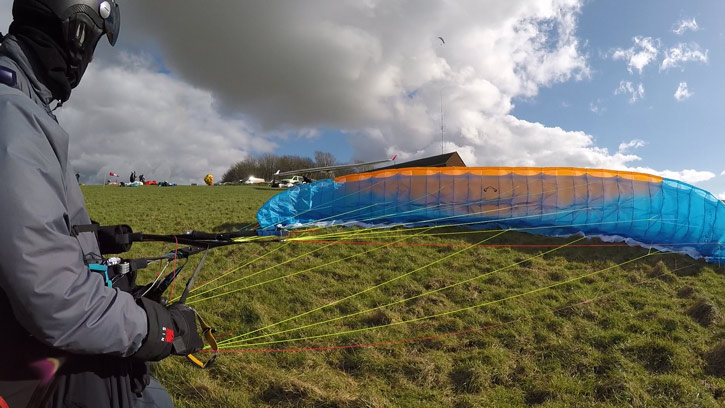
Find out more about the Advance Alpha 6 >
